
I currently own no fewer than a dozen types of salt, and my collection grows every week. I adore salt. I love it on all foods, savory or sweet. I love the sharp, metallic taste of bare crystals on my tongue. I love the variety that salt has to offer: shapes, sizes, colors, flavors. When I come home from work, I make myself a plate of salted olive oil for dipping bread. When I dress my salad, it isn’t complete without a rough crushing of coarse flake salt over the top. When I’m cooking proteins or plants, I choose my salt deliberately, as that single ingredient will affect the final flavor of my dish more than any other.
However, salt has become a hopelessly neglected ingredient in everyday cooking. If you were to ask 100 random people to name as many salts as possible, what do you thin the results would be? I suspect at least 30 people wouldn’t believe that salt comes in more than one form: table salt. Perhaps 70/100 might be able to name Morton’s iodized salt. Maybe 50/80 would mention kosher salt. I’d be surprised if more than 30/100 thought of rock salt (unless they live somewhere snowy or make a lot of ice cream), and I’d be flabbergasted if more than 10/100 conjured up “sea salt”. I have little hope that 1/100 could produce any of the adjectives that adorn my salt jars: alderwood smoked, red Hawaiian, Niçoise olive, cyprus flake, Australian pink, Himalayan (the list continues). It’s these variations that make salt so interesting and exciting to me. Could you imagine living life only eating one type of cheese or drinking one type of wine? I’d rather suffer through daily waterboarding with a Mexican Zinfandel than being relegated to plain table salt for the rest of my life. And in a world where the most obscure artisanal products are only a mouse click away from your doorstep, there’s really no excuse to turn your back on good salt.
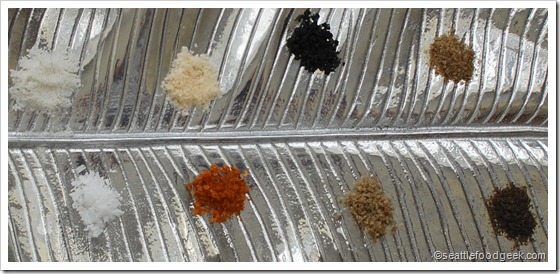
In celebration of this wonderful ingredient, Rachel and I hosted a salt-themed dinner party for our gourmet club last weekend. Our mission was two-fold: 1) incorporate, worship and evangelize salt as a basic but richly complex ingredient, and 2) get everyone gleefully drunk (in fairness, #2 applies to every meeting of our gourmet club). We began the evening with a simple introduction to a few of my favorite seasoned salts, plated with olive oil and soft baguette slices. These salts included Chili Verde, Black Truffle, Chardonnay Oak Smoked, and Niçoise olive. The table favorite, in this preparation, was the black truffle salt, which has a pronounced aroma and a very fine grain. I often use only this truffle salt and a little olive oil to season roasted birds, but it’s also great for finishing pastas or sautéed vegetables.
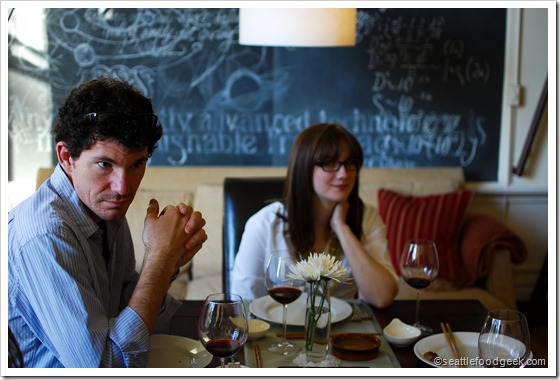
Next, we tried something completely novel but totally fun: salt slab tableside cooking! I ordered a Himalayan salt slab (also available from Sur La Table and Dean & Deluca) which is literally a solid salt brick cut from deposits deep beneath the Himalayan mountains. The slab is a beautiful shade of translucent pink with light veins and a coarse texture. Following some tips I read online, I heated the slab gradually for 30 minutes on my stovetop, then brought it to the table and set it atop a rack (my fondue rack, actually). Unfortunately, we barely got a sizzle, even though the block felt quite hot. About 10 minutes on broil in the toaster oven helped, as did the Sterno fondue flame I lit beneath the brick. (Note: I never read anywhere that you’re supposed to place the salt over a Sterno flame, so if you try it and disaster ensues, tough nuggies. However, it worked pretty well for me, with no obvious resulting structural damage. Plus, the salt conducted the flame’s heat pretty well, giving us 10-15 minutes of usable cook time at the table.)

We seared thin slices of marinated hanger steak with a peanut dipping sauce. Even though the marinade was (intentionally) not very salty, the beef picked up great salt flavor from the brick. If you try this recipe (which I’ll post soon) be aware that the marinade tends to drip off the side of the block, so you may want to take precautions to protect your table and linens. After we ran out of beef, we gave a go at frying an egg on the salt brick. The result was a very salty, but incredibly delicious, umami-flavored egg. Yum! I could get quite used to cooking on the salt block, as everything it touches turns to salty gold.
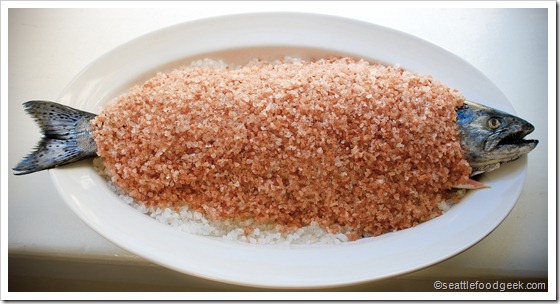
Next up was the main course: a whole sockeye salmon baked in a crust of Himalayan rock salt. Since the salmon is cooked intact and with the skin on, the resulting flesh doesn’t end up particularly salty. However, because the crust provides an insulating layer that heats the fish evenly and traps steam in, you do end up with tender, succulent fish, plus an awesome presentation. Before entombing the salmon, the salt is mixed with egg whites and a little water to form a slush, not unlike wet sand. As the dish bakes, the salt crust hardens into a tough shell. Once the dish is cooked and rested, you can tap the crust with a kitchen knife (or chisel, if necessary) to remove it in (hopefully) big chunks.
I stuffed the inside of the salmon with lemon slices and oregano, which lent a light fragrance to the baked fish. Once cooked and removed from the salt, we served pieces of the fillet atop fennel and onion confit with a sweet olive jam.
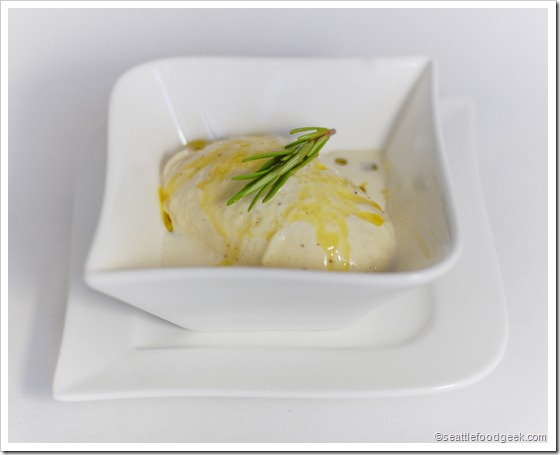
Finally, after seven bottles of wine and two hours of eating, we arrived at dessert – the course I had been waiting for all evening. I served a homemade rosemary and vanilla bean ice cream topped with olive oil and sea salt. The combination of savory flavors with ice cream may sound bizarre, but when these ingredients get together, they make funky, sexy love to my mouth. You can use any salt you like to top this ice cream (I’d recommend a flake sea salt or a gray salt), but be sure to use an olive oil that will compliment the sweetness dessert. I chose Villa Manodori ($24 at DeLaurentis, also available online) , which is mild and thin, but has a distinctly fresh olive taste and a spicy bite as it finishes. My every-day extra virgin olive oil would been a little too thick and greasy, so this dish was a good excuse to spring for a nice bottle.
Recipe: Rosemary, Olive Oil and Sea Salt Sundae
Throughout the meal, we watered our salty tongues with bites of fresh Tuscan Canteloupe and glasses of light, fruity wines like Sangiovese, Gewurztraminer and Soave. The melon was a surprisingly effective palate cleanser – I’d recommend having it on the table if you plan on throwing your own salt party. And in addition to the wine, offering a glass of Port or Muscat as an accompaniment to your dessert, or a store-bought salted chocolate, helps illuminate how salty flavors can enhance sweet ones.
I feel like we’re at the doorstep of a new renaissance for salt. With artisanal salt makers like SaltWorks and Secret Stash Salts popping up in grocery stores and farmers markets, and products like Himalayan salt blocks appearing in mainstream catalogs, salt has a good shot at grabbing the spotlight. And after 8000 years of cooking with this simple, amazing ingredient, isn’t about time we gave salt the recognition it deserves?
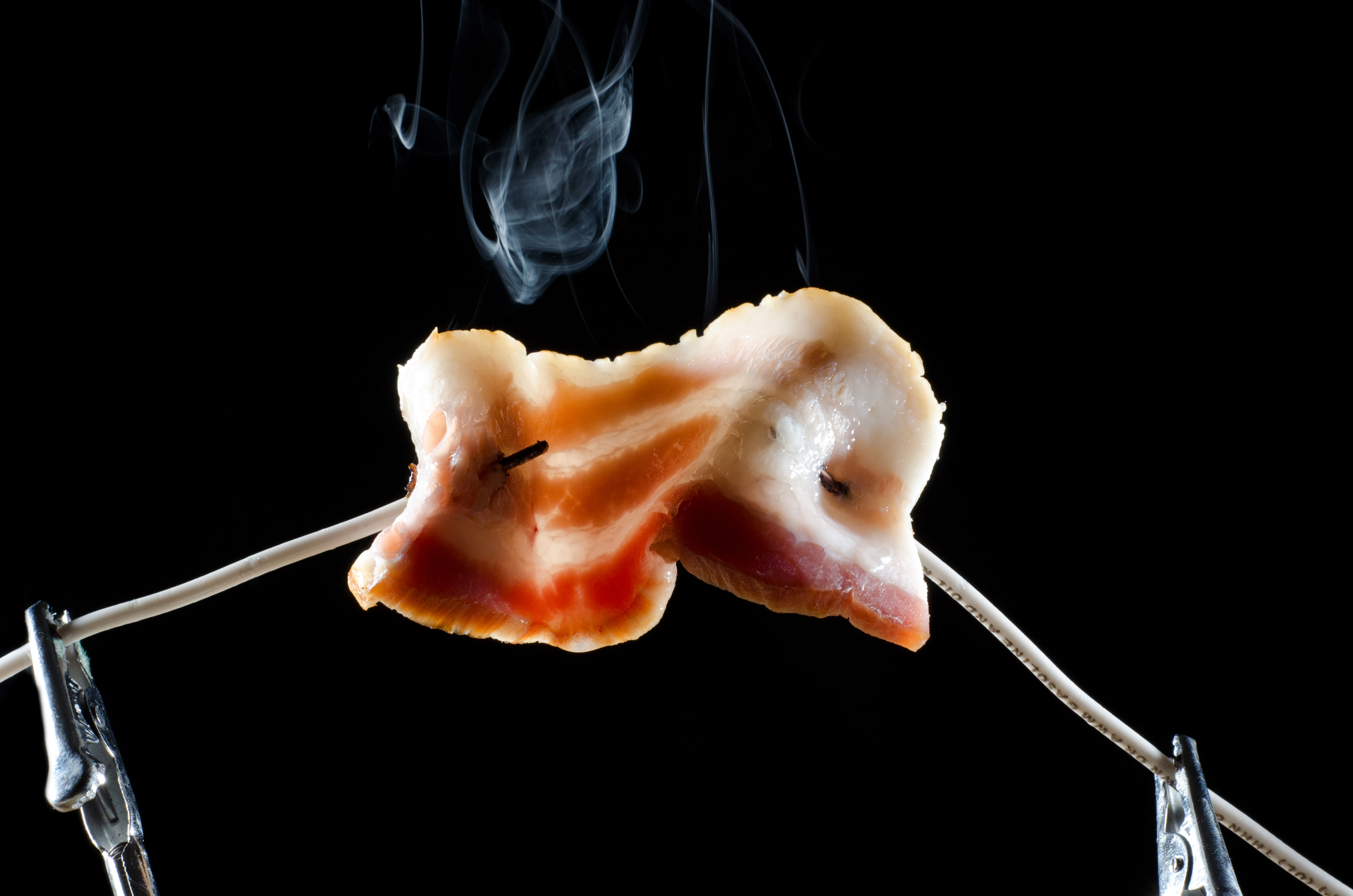
What an absolutely awesome party! I too am a raving salt lover so can appreciate the theme immensely and am sure I would have loved the food!
I loved this post and it certainly made me hungry! I agree that salt needs to make a comeback. It has gotten such an unnecessary bad rap. I renewed my love of salt with some Himalayan sea salt from Sustainable Sourcing http://www.himalasalt.com. It is just excellent and I can never go back!
Hi Scott,
I can’t decide which I’m most captivated by: the thought of throwing a salt dinner party, or a whole salmon baked in Himalayan rock salt. The fish, and photography are equally stunning!
I’m also thrilled that you’re just as excited about salt as we are, and flattered that our Nicoise Olive salt made it to the party.
*Inspired*
Janna
That’s a nice table you got there!
Did you read Jeffrey Steingarten’s essay about salt? Turns out most people can’t tell the difference bewteen the salts when they are dissovled and blind tasted. Unless they have a very very fine palate (like Jeffery :)).
That chalkboard is incredible. Did you do it yourself or buy it somewhere? Sorry if you talked about this earlier. I just found this blog.
The chalkboard is actually original to my home (and 100 years old!). I hired an artist to create that design, but it is intentionally temporary. I keep telling myself I’ll change it one day, but never have.
What an impressive meal! I was trying to explain the salt-encrusted baking method to a friend and she was giving me the WTF-are-you-talking-about look, so I think I’ll send her your post to help as a visual aid.
You mentioned a gourmet club in this post. I am a foodie myself and looking to join such club. Do you have any recommendations regarding that. thanks!
Hi Sobia,
Why not start your own? Find a few friends at work or neighbors who share an interest in food and entertaining and arrange monthly get-togethers. It’s helpful to choose a theme and assign all of the responsibilities of the evening to the host couple. That way, the whole meal will have continuity and you’ll be able to take all the credit :-
)
Hello Scott,
I just received a Himalayan salt slab as a gift, and am trying to think of the best way to use it. Have you used one since this dinner party? Any other tips? I like the idea of refrigerating it and then curing beef carpaccio and/or fish on it. I also plan on trying this:
http://www.richardhuff.com/archives/100-cooking-on-a-himalayan-salt-slab.html
Sounds like the key is to get it REALLY hot. I also like the idea of searing steaks on it, as I’ve been really into using my sous vide controller and rice cooker apparatus and then searing steaks over a charcoal chimney. Might also be a great way to sear boneless skinless chicken breasts, as using a pan in the kitchen is MESSY and my side burner on my BBQ isn’t hot enough. Putting this bad boy in my gas grill should work nicely. 😉
Thanks!
Okay, I’m super late to this comment party, but I couldn’t help myself from mentioning that the fish in that picture is NOT a sockeye. The good news is, I suspect that it is a king salmon, which is the most highly prized Pacific salmon species. (I can’t say for sure without seeing the whole fish, but the tail is an excellent species indicator.) Sockeye have translucent tails, with no discernible silver markings, and never have spots on their tails or backs. (Salmon geek here, I work on a commercial fishing boat in Alaska.)
In any case, that looks like a fabulous preparation for a whole salmon! I love your photos!